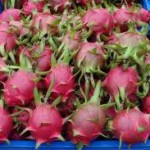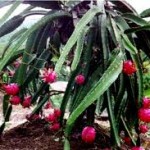Dragon fruit, is locally known as “saniata” in northern Philippines. The fruit belongs to the Cactaceae family.
The crop can be grown and adaptable to marginal upland areas and sand dunes.
It is called dragon fruit because it is covered by green-tipped overlapping scales and has bright pink to red color. It is sweet, juicy, crispy, and tastes like pear, kiwi, and watermelon.
Dragon fruit, known as pitahaya in Central and South America where it is native to, was introduced in the Philippines in 1900s through trading. This vine-like epiphytic cactus is also cultivated in Malaysia, Vietnam, Taiwan, Thailand, and Southeast China.
Idle areas can be utilized in the propagation of dragon fruit, to make the land productive.
A seven-hectare dragon fruit plantation, can yield 10 to 12 metric tons in a year. They can be harvested six to seven times since the start of the fruiting season each year.
It takes one month from flower bud formation before a fruit could be harvested. The flowers open 10 days after flower bud formation. It will also take 10 days for the fruits to develop and another 10 days to mature.
An investor can easily get back a return of his investment (ROI) in the second year. The fruit is pegged at Php 200 pesos (US$ 5 dollars) to Php 250 pesos (US$ 6 dollars) per kilogram.
Dragon fruit typical nutritional value per the Department of Science and Technology (DoST), is rich in fiber, vitamins, minerals and phytoalbumins.
With its phytoalbumin content, which acts as an antioxidant, the dragon fruit is said to prevent the formation of cancer.
Its other heath benefits are as follows: enhances the body metabolism (protein), improves digestion (fiber), reduces fat (fiber), improves memory (carotene).
It maintains the health of the eyes (carotene), strengthens bones and teeth development (calcium), helps metabolize carbohydrates and produces energy (vitamin B1).
It moisturizes and smoothens skin and decreases cholesterol level (vitamin B3), reduces hypertension (B-Sitosterol), and the list goes on.
Other than the flesh of the fruit, the unopened buds, dried flowers, and fruit skin can also be processed into food.
The unopened buds can be made into a delicious fresh salad. The dried flowers, on the other hand, can be cooked into lumpiang shanghai, a Chinese delicacy.
Likewise, the dried flowers can be used as an ingredient for bulalo broth and can also be processed into delicious dragon balls (meatballs).
The fruit skin, can also be cooked with moringa (malunggay) leaves and can also be processed into jam.

